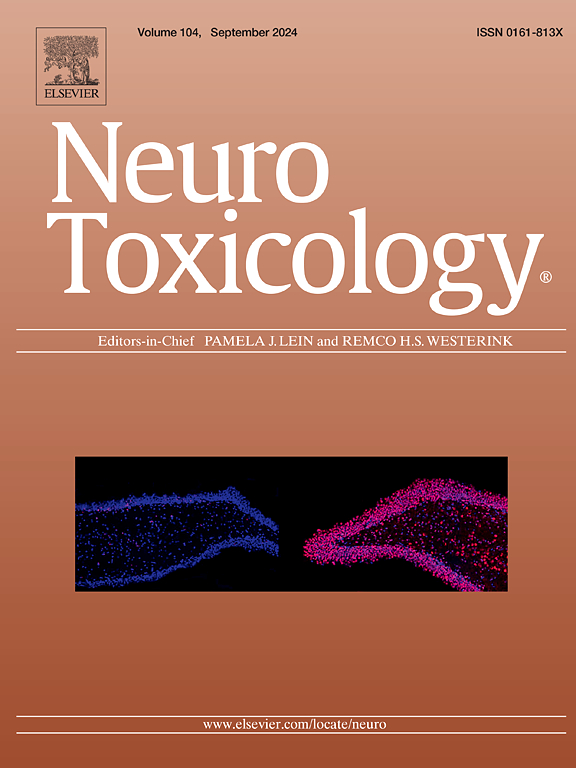Simultaneous study of cochleotoxicity and vestibulotoxicity of 3,3’- iminodipropionitrile in rats through several experimental approaches
IF 3.9
3区 医学
Q2 NEUROSCIENCES
引用次数: 0
Abstract
Many industrial chemicals and clinical compounds are toxic to the inner ear. Some preferentially target the cochlea or vestibular structures, whereas others are harmful to both. The reasons behind these distinct ototoxic profiles remain poorly understood. The lack of a clear structure-toxicity relationship means that the prediction of the ototoxic potential of new drugs or chemical compounds is challenging and that in vivo testing is necessary. Vestibular or cochlear toxicity can be readily assessed independently, but we lack a method to simultaneously evaluate both functional and histological impairments in the same animals. Here, we describe and test such a method using 3,3’-iminodipropionitrile (IDPN), a compound known to induce hair cell loss in both cochlear and vestibular epithelia in the inner ear of rodents. Female Long-Evans rats were treated with IDPN (0, 150, 200, or 300 mg/kg/day for three days, i.p.). Auditory function was assessed using distortion product otoacoustic emissions (DPOAEs), while vestibular function was evaluated by measuring post-rotatory nystagmus (PRN) and anti-gravity reflexes: the tail-lift and air-righting tests. These tests were conducted before, and four weeks after treatment. Inner ears were collected to count hair cells and to examine the cochlea, utricle, saccule, and cristae by scanning electron microscopy (SEM). Auditory and balance deficits, as well as histological damage in all epithelia, were observed from 200 mg/kg/day, with a strong correlation between functional impairments and histological findings. The method described provides a comprehensive and unbiased means to compare vestibular and cochlear toxicity.
通过几种实验方法同时研究3,3′-亚氨基二丙腈对大鼠的耳蜗毒性和前庭毒性。
许多工业化学品和临床化合物对内耳有毒。有些优先针对耳蜗或前庭结构,而另一些则对两者都有害。这些不同的耳毒性特征背后的原因仍然知之甚少。缺乏明确的结构-毒性关系意味着预测新药或化合物的耳毒性潜力具有挑战性,并且有必要进行体内试验。前庭或耳蜗毒性可以很容易地独立评估,但我们缺乏一种同时评估同一动物的功能和组织学损伤的方法。在这里,我们使用3,3'-亚氨基二丙腈(IDPN)描述和测试了这种方法,IDPN是一种已知可诱导啮齿动物内耳耳蜗和前庭上皮毛细胞脱落的化合物。雌性Long-Evans大鼠分别给予IDPN(0、150、200、300mg/kg/d, ig,连续3天)治疗。通过畸变产物耳声发射(dpoae)评估听觉功能,通过测量旋转后眼震(PRN)和反重力反射(尾举和空气矫正测试)评估前庭功能。这些测试分别在治疗前和治疗后四周进行。采集内耳毛细胞计数,扫描电镜观察耳蜗、耳室、囊、嵴。从200mg/kg/天开始,观察到听觉和平衡障碍,以及所有上皮的组织学损伤,功能损伤与组织学结果有很强的相关性。所描述的方法提供了一种全面和公正的方法来比较前庭和耳蜗毒性。
本文章由计算机程序翻译,如有差异,请以英文原文为准。
求助全文
约1分钟内获得全文
求助全文
来源期刊

Neurotoxicology
医学-毒理学
CiteScore
6.80
自引率
5.90%
发文量
161
审稿时长
70 days
期刊介绍:
NeuroToxicology specializes in publishing the best peer-reviewed original research papers dealing with the effects of toxic substances on the nervous system of humans and experimental animals of all ages. The Journal emphasizes papers dealing with the neurotoxic effects of environmentally significant chemical hazards, manufactured drugs and naturally occurring compounds.
 求助内容:
求助内容: 应助结果提醒方式:
应助结果提醒方式:


